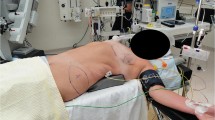Abstract
Background
Many surgical methods have been used to repair sacral sores, including primary closure, skin grafting, local random, and muscle flaps. After the description of the gluteal perforator-based flap, the perforator-based fasciocutaneous flap became popular in lumbosacral tissue defect reconstruction.
Methods
Multiple perforatory preserving superior gluteal artery perforator (SGAP) flap was performed in eight patients with lumbosacral soft tissue defects from May 2014 to April 2015. Five men and three women received the operation. The causes of defects were pilonidal sinus defect in five patients and pressure ulcer in three patients. All patients were mobile and did not have any systematic diseases.
Results
The average age of the patients was 45 years. The follow-up period was 2 to 12 months (mean, 6 months). The size of the flap ranged from 8 × 10 to 10 × 16 cm. All flaps healed completely without any vascular problem. Only one patient suffered from dehiscence. The average operative time was 160 min (range 120–200 min). Patients were immediately allowed to lie on the operated area (but no longer than 1 h at a time for the first 48 h). They were allowed to gradually sit after 72 h. The mean time for removal of suction drains was 8 days (5–14) while mean duration of hospital stay was 7.5 days (3–14 days).
Conclusions
It was seen that multiple perforatory preserving SGAP flap is a safe and reliable flap. No vascular complications was seen in postoperative period. Preserving multiple perforators in SGAP flap is time-consuming and increases the necessary time for flap harvest which is the main drawback of our technique.
Level of Evidence: Level IV, therapeutic study






Similar content being viewed by others
References
Kierney PC, Engrav LH, Isik FF et al (1998) Results of 268 pressure sores in 158 patients managed jointly by plastic surgery and rehabilitation medicine. Plast ReconstrSurg 102:765–772
Acarturk TO, Parsak CK, Sakman G et al (2010) Superior gluteal artery perforator flap in the reconstruction of pilonidal sinus. J Plast Reconstr Aesthet Surg 63:133–139
Minami RT, Mills R, Pardoe R (1977) Gluteus maximus myocutaneous flaps for repair of pressure sores. Plast Reconstr Surg 60:242–249
Relander M, Palmer B (1988) Recurrence of surgically treated pressure sores. Scand J Plast Reconstr Surg Hand Surg 22(1):89–92
Parry SW, Mathes SJ (1982) Bilateral gluteus maximus myocutaneous advancement flaps: sacral coverage for ambulatory patients. Ann Plast Surg 8:443–445
Stevenson TR, Pollock RA, Rohrich RJ et al (1987) The gluteus maximus musculocutaneous island flap: refinements in design and application. Plast Reconstr Surg 79:761–768
Koshima I, Moriguchi T, Soeda S et al (1993) The gluteal perforator-based flap for repair of sacral pressure sores. Plast Reconstr Surg 91:678–683
Verpaele AM, Blondeel PN, Van Landuyt K et al (1999) The superior gluteal artery perforator flap: an additional tool in the treatment of sacral pressure sores. Br J Plast Surg 52:385–391
Blondeel PN, Van Landuyt K, Hamdi M et al (2003) Soft tissue reconstruction with the superior gluteal artery perforator flap. Clin Plast Surg 30:371–382
Ahmadzadeh R, Bergeron L, Tang M et al (2007) The superior and inferior gluteal artery perforator flaps. Plast Reconstr Surg 120:1551–1556
Song WC, Bee SM, Han SH et al (2006) Anatomical and radiological study of the superior and inferior gluteal arteries in the gluteus maximus muscle for musculocutaneous flap in Koreans. J Plast Reconstr Aesthet Surg 59:935–941
Tansatit T, Chokrungyaranont P, Sanguansit P et al (2008) Anatomical study of the superior gluteal artery perforator (S-GAP) for free flap harvesting. J Med Assoc Thail 91:1244–1249
Meltem C, Esra C, Hasan F et al (2004) The gluteal perforator-based flap in repair of pressure sores. Br J Plast Surg 57:342–347
Author information
Authors and Affiliations
Corresponding author
Ethics declarations
Conflict of interest
Burak Ersen, Ramazan Kahveci, Ismail Aksu, and Orhan Tunali declare that they have no conflict of interest.
Ethical standards
For this type of retrospective study formal consent from a local ethics committee is not required.
Fundings
The creation of this article was not supported by any outside funds.
Patient consent
Informed consent was obtained from all individual participants included in the study.
Rights and permissions
About this article
Cite this article
Ersen, B., Kahveci, R., Aksu, I. et al. Multiple perforator preserving SGAP flap for the reconstruction of sacral wounds. Eur J Plast Surg 39, 193–196 (2016). https://doi.org/10.1007/s00238-015-1157-3
Received:
Accepted:
Published:
Issue Date:
DOI: https://doi.org/10.1007/s00238-015-1157-3




